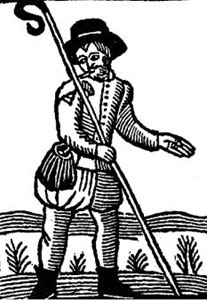The Creake, Kreke, Creke ect. family were what become known as yeoman. These were well-to-do farmers and small land-owners who owned land in their own right and also rented additional land from other land-owners both large and small in their home and nearby parishes. The yeoman of Kent were thought to be especially well off, a popular rhyme of the early 16th century was:-
“A knight of Cales [Calais], and a gentleman of Wales,
And a laird of the north country –
A yeoman of Kent with his yearly rent
Could buy them out – all three.”
The following inventory made on the death of Richard Creake of Kettenton (Kittington) gives a good insight into the daily life of a yeoman’s family. The Creake household had a fairly varied diet which included meat, fish, eggs, and dairy produce and they brewed their own beer and ale for daily consumption as the water was often not safe to drink. In common with the times they were mixed farmers, rearing livestock and poultry and growing cereals. Hemp and flax was also grown and used to produced yarn to weave into cloth, presumably for their own use. Most farms and smallholdings had hemp plots well into the 19th century. Hemp plots are mentioned in many deeds of conveyance and rental agreements, and on farm and parish maps.

The inclusion of armour and weapons in the inventory indicates that English men could still be called for military service when the situation demanded, as is the case of threatened invasion by the French during the 1540’s during Henry VIII’s wars with France. The English had only finally lost Calais to the French in 1558. Orders compelling the practise of archery continued to be enacted until the reign of Charles I (1633).
The household was well equipped, for the time, with furniture, fittings and household and kitchen utensils. The family would have had live in servants and labourers who had to be fed, so the kitchen would have been busy.
The farm itself was well equipped with carts, ploughs and other agricultural tools and equipment.
An inventory of the goods of Richard Creake, yeoman, of (Kettingden or Kittington) Nonington, Kent. 1560.
Imprimis, a purse, a girdle and monnye
42s
Item, hys apparel, iii cotts, one clock, I doublet of worsted, ii jerkyns, ii payr of hose, iii shirts, ii payr of sheets, a capp
50s
Item, a payr of sheets, ii table clothes, ii towels
20s
Item, iii bedsteds, ii fether beds, v traunces, vi pillows, ii payr of sheets, viii underclothes, iii coverlets, one carpet, a blanket, a quilt, a paynted tester (canopy), ii cusshons
£.4 9s 4d
Item, iii chests, one counter table, one olde cubborde, a cradle
15s
Item, xii pounds of lynnen yarn
6s
Item, a quarter and a half of lams woll, a hamper,
ii f-?-cers
2s 8d
Item, one Almayne rynet (German helmet) a javalyn (javelin), ii bylles (bills, bill hooks), a sheaf of arroes, a sworde, a shred coverlet, ii old paynted clothes (painted cloth wall hangings-much cheaper than tapestry-shows a fairly wealthy household with a large area of walls-a fairly high status building-probably the old Kettingden/Kittington manor house)
10s
Item, a gallon of butter, xvi chesses
8s
Item, 320 fete of borde (wooden boards for building)
10s 8d
Item, a lynnen whele (spinning wheel for linen thread), a wollen woollen (sic) whele (spinning wheel for woollen thread), ii payr of cardes (for carding wool before spinning), ii fork combes (either for personal use or processing wool?), iii chest baylys, iii olde bordes
4s 4d
Item, of sickkelles and hokes and other olde yrne (iron-farm tools)
6s 8d
Item, the best cubborde, a fourme (bench), ii stoles (stools), a matt
11s 4d
Item, ii brasse pottes, 11 stoppers
8s
Item, iii kettles, one pann
3s 4d
Item, of pewter Vii platters, viii pewter dishes, iiii sausers, I pewter pott, a buntyn (coarse cloth bag/sack-made from bunting?) [of] salte, vi spones of pewter
12s
Item iiii candlesticks, a chafing dishe, a skimmer, a drypinge pann
(A chafing dish (from the Old French chauffer, “to make warm”) is a kind of portable grate raised on a tripod, originally heated with charcoal in a brazier, and used for foods that require gentle cooking, away from the “fierce” heat of direct flames.)
2s4d
Item, woddyshe (wooden) trenchers, cups and crucs (dishes)
10s
Item, iiii trayes, xii booles (bowls)
5s
Item, ii tryvetts, a grydirne, ii payr of pot hangers, a fyer rake, a spytt, a payr of pot hokes
4s
Item, iii stonds, one yelyng tonne (vat for fermenting wort for beer), xii tubs, ii hundrish (hundred weights?) of herrynge and witing
4s 8d
Item wheat sowen upon the grounde vij acres
£.3 15s
Item of pease and tars (tares) by estimacion lxxvj (?cps)
£.1 5s 4d
Item one loade of haye
6s 4d
Item iij horss(es) a carte wt shodde wheles and carte harness a couer (small cart?) with shode wheles
£.7
Item a plough with the apparrells three harrowes a Roole (rol or rollerl)
8s
Item two bacon hoggs iiij lywar hoggs
£.1 4s
Item xiiij hennes (possibly pullets-less than a year old) twoo capons (castrated cockerel for eating) twoo cockes ffyve chickens (possibly hens more than a year old)
8s 2d
Item three kyene (kine-plural of cow-presumably milch cows) one hayffer (cow before having her first calf) one weyninge (weaning) calfe
£.5 4s 4d
Item of whethers (male sheep, usually castrated) xxviij
£.5 4s
Item xxij Ewes
£.3 4s 4d
Item xv tags (teggs-ewes in their second year before their first shearing)
£.1 15s
Item a busshell a fan the wattles of the folde the hogge troffe wth other blockes and stocks and implements forgotten by us the prysers
9s 4d
SMm TOTALIS HUIUS INUENTARII £.66 6s 8d


